Abstract
The effect of natural killer (NK) cells on the course of acute and persistent murine cytomegalovirus (MCMV) infection was examined by selectively depleting NK cell activity by inoculation of mice with antibody to asialo GM1, a neutral glycosphingolipid present at high concentrations on NK cells. The dose of MCMV required to cause 50% mortality or morbidity in control C57BL/6 mice dropped 4- and greater than 11-fold, respectively, in mice first treated with anti-asialo GM1. NK cell-depleted mice had higher (up to 1,000-fold) virus titers in their lungs, spleens, and livers at days 3, 5, 7, and 9 postinfection. Spleens and livers of control mice were virus-free by day 7 postinfection, and their lungs showed no signs of active infection at any time. In contrast, MCMV had disseminated to the lungs of NK cell-depleted mice by day 5, and these mice still had moderate levels of virus in their lungs, spleens, and livers at day 9. Markedly severe pathological changes were noted in the livers and spleens of NK cell-depleted, MCMV-infected mice. These included ballooning degeneration of hepatocytes and spleen necrosis. MCMV-infected, NK cell-depleted mice had severe spleen leukopenia, and their spleen leukocytes exhibited a significantly lower (up to 13-fold) response to the T cell mitogen concanavalin A when compared with those of uninfected and MCMV-infected controls. It appeared that NK cells exerted their most potent antiviral effect early in the infection, in a pattern correlating with interferon production and NK cell activation; treatment with anti-asialo GM1 later in infection had no effect on virus titers. The relative effect of NK cell depletion on MCMV pathogenesis depended on the injection route of the virus. NK cell depletion greatly augmented MCMV synthesis and pathogenesis in mice inoculated either intravenously or intraperitoneally but had no effect on the course of disease after intranasal inoculation, at any time point examined. One month after intraperitoneal inoculation of virus, NK cell depletion resulted in a six- to eightfold increase in salivary gland virus titers in persistently infected mice, suggesting that NK cells may be important in controlling virus synthesis in the salivary gland during persistent infection. This treatment did not, however, induce dissemination of virus to other organs. These data support the hypothesis that NK cells limit the severity, extent, and duration of acute MCMV infection and that they may also be involved in regulating the persistent infection.
Full text
PDF
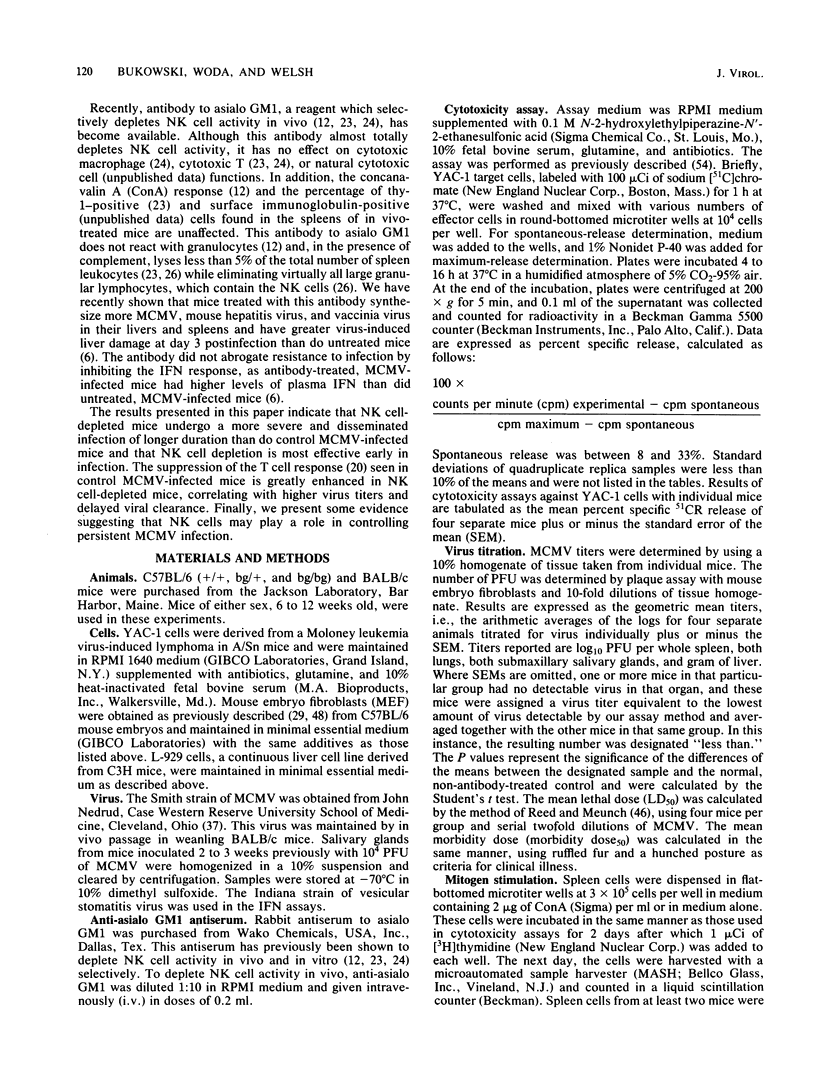

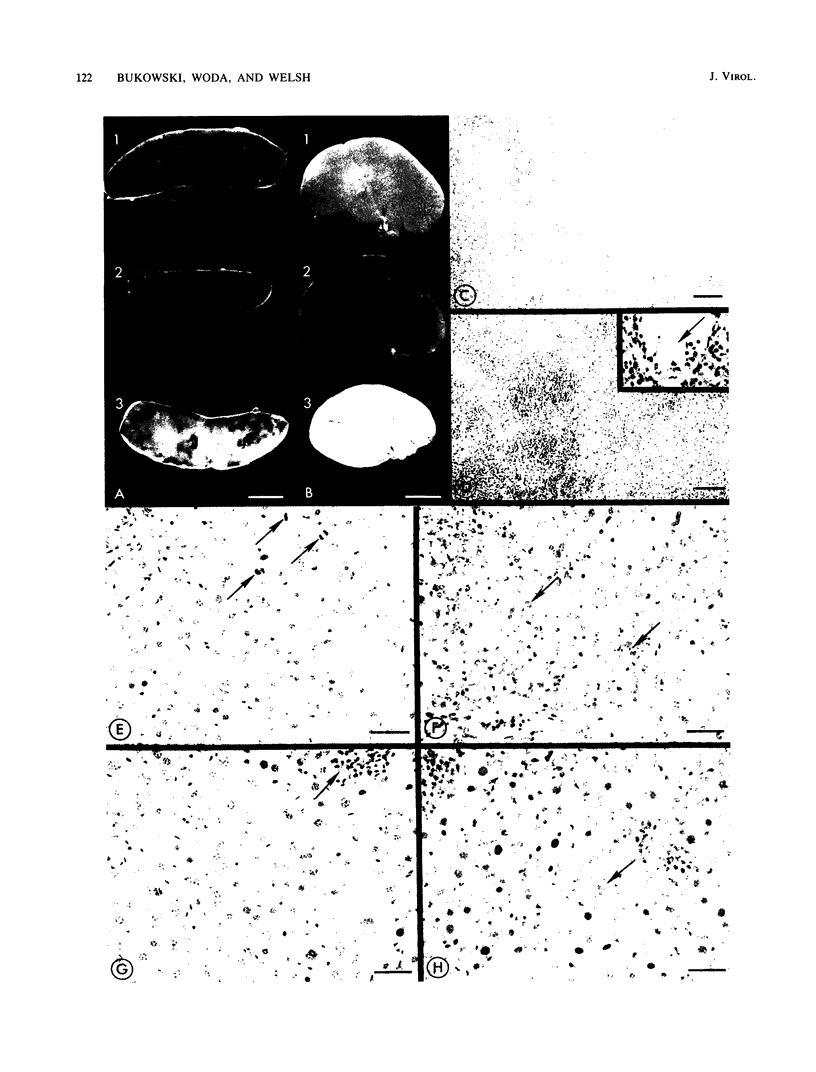

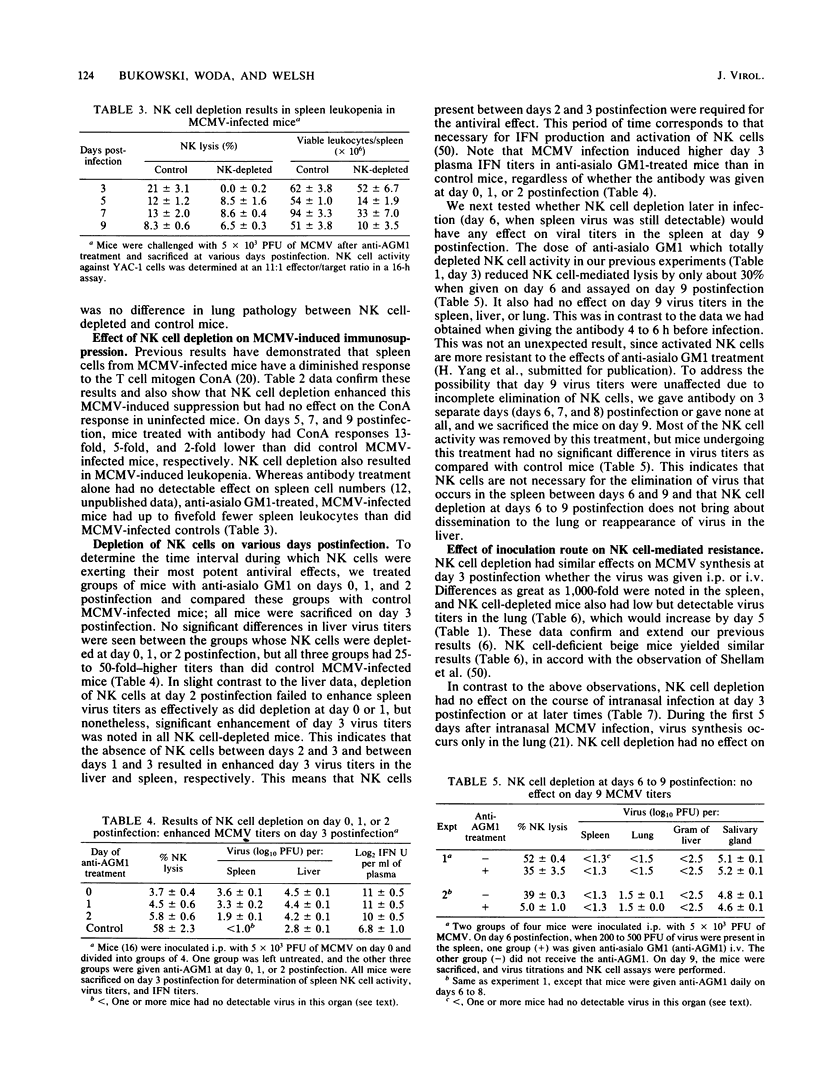

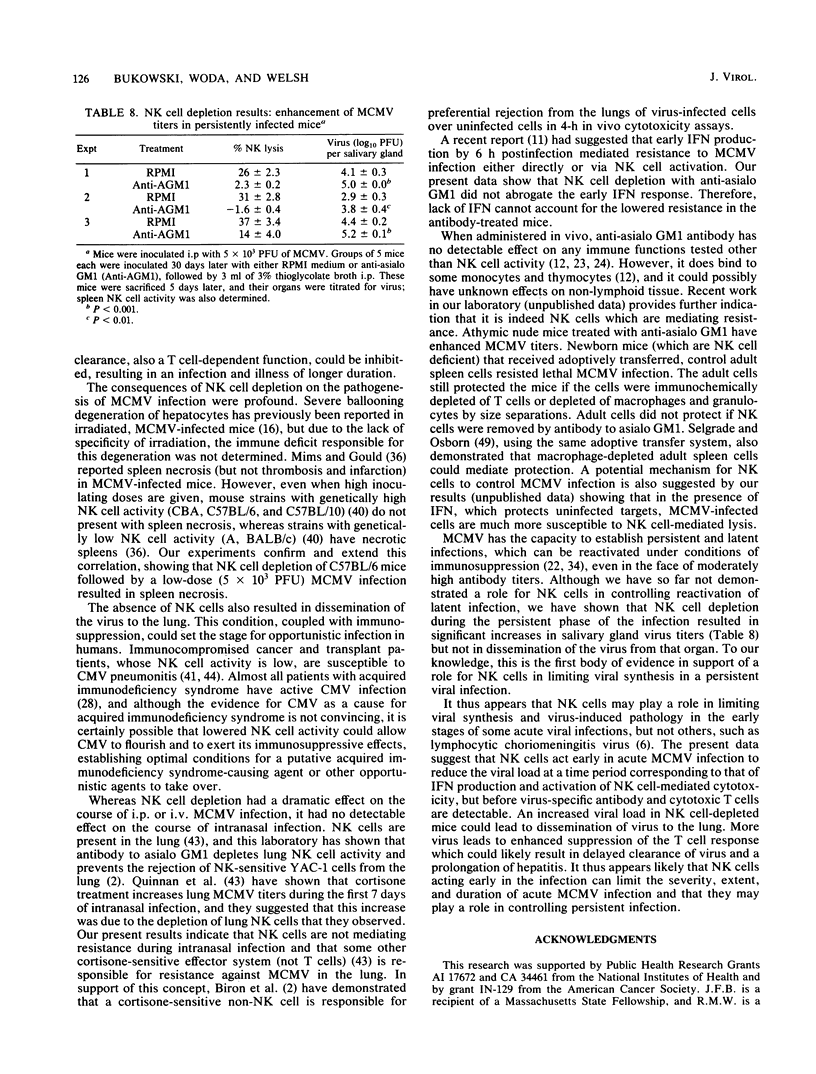

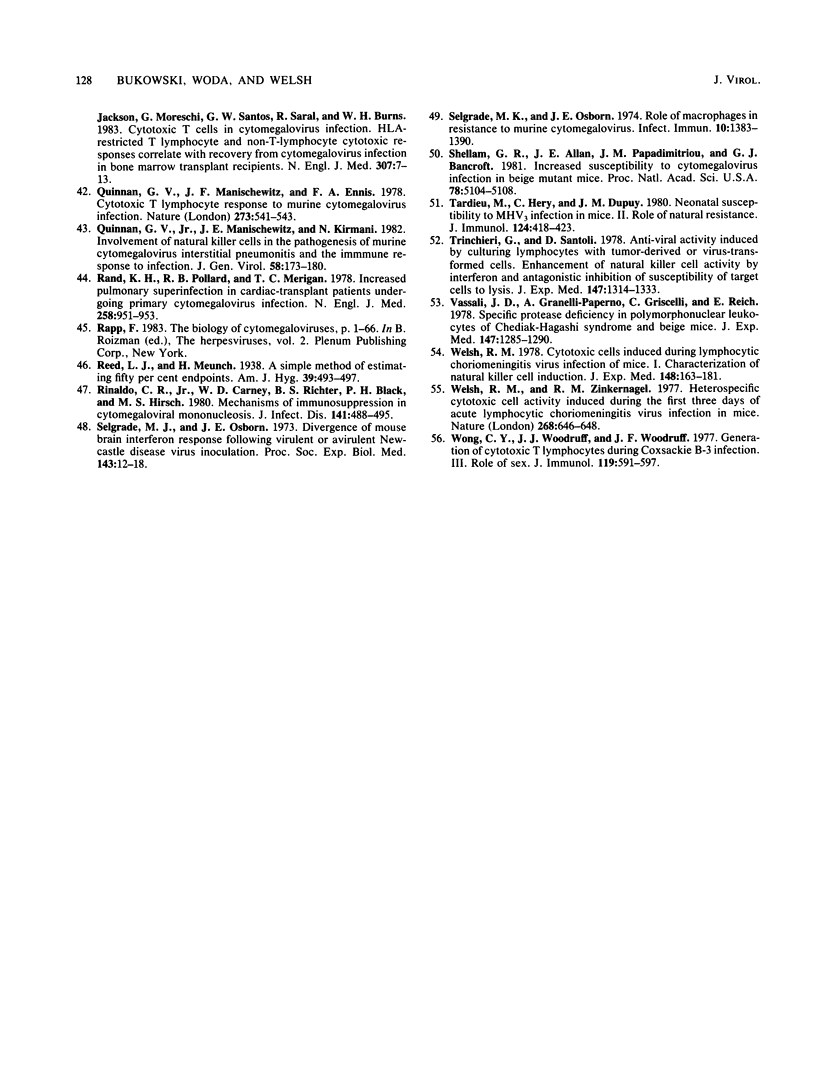
Images in this article
Selected References
These references are in PubMed. This may not be the complete list of references from this article.
- Bancroft G. J., Shellam G. R., Chalmer J. E. Genetic influences on the augmentation of natural killer (NK) cells during murine cytomegalovirus infection: correlation with patterns of resistance. J Immunol. 1981 Mar;126(3):988–994. [PubMed] [Google Scholar]
- Biron C. A., Habu S., Okumura K., Welsh R. M. Lysis of uninfected and virus-infected cells in vivo: a rejection mechanism in addition to that mediated by natural killer cells. J Virol. 1984 Jun;50(3):698–707. doi: 10.1128/jvi.50.3.698-707.1984. [DOI] [PMC free article] [PubMed] [Google Scholar]
- Biron C. A., Turgiss L. R., Welsh R. M. Increase in NK cell number and turnover rate during acute viral infection. J Immunol. 1983 Sep;131(3):1539–1545. [PubMed] [Google Scholar]
- Brautigam A. R., Dutko F. J., Olding L. B., Oldstone M. B. Pathogenesis of murine cytomegalovirus infection: the macrophage as a permissive cell for cytomegalovirus infection, replication and latency. J Gen Virol. 1979 Aug;44(2):349–359. doi: 10.1099/0022-1317-44-2-349. [DOI] [PubMed] [Google Scholar]
- Bukowski J. F., Biron C. A., Welsh R. M. Elevated natural killer cell-mediated cytotoxicity, plasma interferon, and tumor cell rejection in mice persistently infected with lymphocytic choriomeningitis virus. J Immunol. 1983 Aug;131(2):991–996. [PubMed] [Google Scholar]
- Bukowski J. F., Woda B. A., Habu S., Okumura K., Welsh R. M. Natural killer cell depletion enhances virus synthesis and virus-induced hepatitis in vivo. J Immunol. 1983 Sep;131(3):1531–1538. [PubMed] [Google Scholar]
- Casali P., Sissons J. G., Buchmeier M. J., Oldstone M. B. In vitro generation of human cytotoxic lymphocytes by virus. Viral glycoproteins induce nonspecific cell-mediated cytotoxicity without release of interferon. J Exp Med. 1981 Sep 1;154(3):840–855. doi: 10.1084/jem.154.3.840. [DOI] [PMC free article] [PubMed] [Google Scholar]
- Chalmer J. E., Mackenzie J. S., Stanley N. F. Resistance to murine cytomegalovirus linked to the major histocompatibility complex of the mouse. J Gen Virol. 1977 Oct;37(1):107–114. doi: 10.1099/0022-1317-37-1-107. [DOI] [PubMed] [Google Scholar]
- Einhorn S., Blomgren H., Strander H. Interferon and spontaneous cytotoxicity in man. I. Enhancement of the spontaneous cytotoxicity of peripheral lymphocytes by human leukocyte interferon. Int J Cancer. 1978 Oct 15;22(4):405–412. doi: 10.1002/ijc.2910220407. [DOI] [PubMed] [Google Scholar]
- Gidlund M., Orn A., Wigzell H., Senik A., Gresser I. Enhanced NK cell activity in mice injected with interferon and interferon inducers. Nature. 1978 Jun 29;273(5665):759–761. doi: 10.1038/273759a0. [DOI] [PubMed] [Google Scholar]
- Grundy J. E., Trapman J., Allan J. E., Shellam G. R., Melief C. J. Evidence for a protective role of interferon in resistance to murine cytomegalovirus and its control by non-H-2-linked genes. Infect Immun. 1982 Jul;37(1):143–150. doi: 10.1128/iai.37.1.143-150.1982. [DOI] [PMC free article] [PubMed] [Google Scholar]
- HANSHAW J. B., BETTS R. F., SIMON G., BOYNTON R. C. ACQUIRED CYTOMEGALOVIRUS INFECTION: ASSOCIATION WITH HEPATOMEGALY AND ABNORMAL LIVER-FUNCTION TESTS. N Engl J Med. 1965 Mar 25;272:602–609. doi: 10.1056/NEJM196503252721202. [DOI] [PubMed] [Google Scholar]
- HEDLEY-WHYTE E. T., CRAIGHEAD J. E. REPORT OF A CASE WITH ISOLATION OF VIRUS. N Engl J Med. 1965 Mar 4;272:473–475. doi: 10.1056/NEJM196503042720907. [DOI] [PubMed] [Google Scholar]
- Habu S., Fukui H., Shimamura K., Kasai M., Nagai Y., Okumura K., Tamaoki N. In vivo effects of anti-asialo GM1. I. Reduction of NK activity and enhancement of transplanted tumor growth in nude mice. J Immunol. 1981 Jul;127(1):34–38. [PubMed] [Google Scholar]
- Hanshaw J. B. Congenital cytomegalovirus infection: a fifteen year perspective. J Infect Dis. 1971 May;123(5):555–561. doi: 10.1093/infdis/123.5.555. [DOI] [PubMed] [Google Scholar]
- Henson D., Smith R. D., Gehrke J. Non-fatal mouse cytomegalovirus hepatitis. Combined morphologic, virologic and immunologic observations. Am J Pathol. 1966 Nov;49(5):871–888. [PMC free article] [PubMed] [Google Scholar]
- Henson D., Strano A. J. Mouse cytomegalovirus. Necrosis of infected and morphologically normal submaxillary gland acinar cells during termination of chronic infection. Am J Pathol. 1972 Jul;68(1):183–202. [PMC free article] [PubMed] [Google Scholar]
- Herberman R. B., Nunn M. E., Holden H. T., Staal S., Djeu J. Y. Augmentation of natural cytotoxic reactivity of mouse lymphoid cells against syngeneic and allogeneic target cells. Int J Cancer. 1977 Apr 15;19(4):555–564. doi: 10.1002/ijc.2910190417. [DOI] [PubMed] [Google Scholar]
- Ho M. Role of specific cytotoxic lymphocytes in cellular immunity against murine cytomegalovirus. Infect Immun. 1980 Mar;27(3):767–776. doi: 10.1128/iai.27.3.767-776.1980. [DOI] [PMC free article] [PubMed] [Google Scholar]
- Howard R. J., Miller J., Najarian J. S. Cytomegalovirus-induced immune suppression. II. Cell-mediated immunity. Clin Exp Immunol. 1974 Sep;18(1):119–126. [PMC free article] [PubMed] [Google Scholar]
- Jordan M. C. Interstitial pneumonia and subclinical infection after intranasal inoculation of murine cytomegalovirus. Infect Immun. 1978 Jul;21(1):275–280. doi: 10.1128/iai.21.1.275-280.1978. [DOI] [PMC free article] [PubMed] [Google Scholar]
- Jordan M. C., Shanley J. D., Stevens J. G. Immunosuppression reactivates and disseminates latent murine cytomegalovirus. J Gen Virol. 1977 Nov;37(2):419–423. doi: 10.1099/0022-1317-37-2-419. [DOI] [PubMed] [Google Scholar]
- Kasai M., Iwamori M., Nagai Y., Okumura K., Tada T. A glycolipid on the surface of mouse natural killer cells. Eur J Immunol. 1980 Mar;10(3):175–180. doi: 10.1002/eji.1830100304. [DOI] [PubMed] [Google Scholar]
- Kawase I., Urdal D. L., Brooks C. G., Henney C. S. Selective depletion of NK cell activity in vivo and its effect on the growth of NK-sensitive and NK-resistant tumor cell variants. Int J Cancer. 1982 May 15;29(5):567–574. doi: 10.1002/ijc.2910290513. [DOI] [PubMed] [Google Scholar]
- Klemola E., Käriäinen L. Cytomegalovirus as a possible cause of a disease resembling infectious mononucleosis. Br Med J. 1965 Nov 6;2(5470):1099–1102. doi: 10.1136/bmj.2.5470.1099. [DOI] [PMC free article] [PubMed] [Google Scholar]
- Kumagai K., Itoh K., Suzuki R., Hinuma S., Saitoh F. Studies of murine large granular lymphocytes. I. Identification as effector cells in NK and K cytotoxicities. J Immunol. 1982 Jul;129(1):388–394. [PubMed] [Google Scholar]
- Kumar V., Bennett M. Genetic resistance to Friend virus-induced erythroleukemia and immunosuppression. Curr Top Microbiol Immunol. 1981;92:65–82. doi: 10.1007/978-3-642-68069-4_5. [DOI] [PubMed] [Google Scholar]
- Lane H. C., Masur H., Edgar L. C., Whalen G., Rook A. H., Fauci A. S. Abnormalities of B-cell activation and immunoregulation in patients with the acquired immunodeficiency syndrome. N Engl J Med. 1983 Aug 25;309(8):453–458. doi: 10.1056/NEJM198308253090803. [DOI] [PubMed] [Google Scholar]
- Lee G. D., Keller R. Natural cytotoxicity of murine cytomegalovirus-infected cells mediated by mouse lymphoid cells: role of interferon in the endogenous natural cytotoxicity reaction. Infect Immun. 1982 Jan;35(1):5–12. doi: 10.1128/iai.35.1.5-12.1982. [DOI] [PMC free article] [PubMed] [Google Scholar]
- Levy-Leblond E., Dupuy J. M. Neonatal susceptibility to MHV3 infection in mice. I. Transfer of resistance. J Immunol. 1977 Apr;118(4):1219–1222. [PubMed] [Google Scholar]
- Lopez C. Resistance to herpes simplex virus - type 1 (HSV-1). Curr Top Microbiol Immunol. 1981;92:15–24. doi: 10.1007/978-3-642-68069-4_2. [DOI] [PubMed] [Google Scholar]
- Macfarlan R. I., Burns W. H., White D. O. Two cytotoxic cells in peritoneal cavity of virus-infected mice: antibody-dependent macrophages and nonspecific killer cells. J Immunol. 1977 Nov;119(5):1569–1574. [PubMed] [Google Scholar]
- Manischewitz J. E., Quinnan G. V., Jr Antivirus antibody-dependent cell-mediated cytotoxicity during murine cytomegalovirus infection. Infect Immun. 1980 Sep;29(3):1050–1054. doi: 10.1128/iai.29.3.1050-1054.1980. [DOI] [PMC free article] [PubMed] [Google Scholar]
- Mayo D. R., Armstrong J. A., Ho M. Reactivation of murine cytomegalovirus by cyclophosphamide. Nature. 1977 Jun 23;267(5613):721–723. doi: 10.1038/267721a0. [DOI] [PubMed] [Google Scholar]
- Michelson-Fiske S. Human cytomegalovirus. A review of developments between 1970 and 1976. I. Clinical developments. Biomedicine. 1977 Feb;26(1):16–22. [PubMed] [Google Scholar]
- Mims C. A., Gould J. Splenic necrosis in mice infected with cytomegalovirus. J Infect Dis. 1978 May;137(5):587–591. doi: 10.1093/infdis/137.5.587. [DOI] [PubMed] [Google Scholar]
- Nedrud J. G., Collier A. M., Pagano J. S. Cellular basis for susceptibility to mouse cytomegalovirus: evidence from tracheal organ culture. J Gen Virol. 1979 Dec;45(3):737–744. doi: 10.1099/0022-1317-45-3-737. [DOI] [PubMed] [Google Scholar]
- Osborn J. E., Blazkovec A. A., Walker D. L. Immunosuppression during acute murine cytomegalovirus infection. J Immunol. 1968 Apr;100(4):835–844. [PubMed] [Google Scholar]
- Quinnan G. V., Jr, Kirmani N., Rook A. H., Manischewitz J. F., Jackson L., Moreschi G., Santos G. W., Saral R., Burns W. H. Cytotoxic t cells in cytomegalovirus infection: HLA-restricted T-lymphocyte and non-T-lymphocyte cytotoxic responses correlate with recovery from cytomegalovirus infection in bone-marrow-transplant recipients. N Engl J Med. 1982 Jul 1;307(1):7–13. doi: 10.1056/NEJM198207013070102. [DOI] [PubMed] [Google Scholar]
- Quinnan G. V., Jr, Manischewitz J. F., Kirmani N. Involvement of natural killer cells in the pathogenesis of murine cytomegalovirus interstitial pneumonitis and the immune response to infection. J Gen Virol. 1982 Jan;58(Pt 1):173–180. doi: 10.1099/0022-1317-58-1-173. [DOI] [PubMed] [Google Scholar]
- Quinnan G. V., Manischewitz J. E., Ennis F. A. Cytotoxic T lymphocyte response to murine cytomegalovirus infection. Nature. 1978 Jun 15;273(5663):541–543. doi: 10.1038/273541a0. [DOI] [PubMed] [Google Scholar]
- Rand K. H., Pollard R. B., Merigan T. C. Increased pulmonary superinfections in cardiac-transplant patients undergoing primary cytomegalovirus infection. N Engl J Med. 1978 Apr 27;298(17):951–953. doi: 10.1056/NEJM197804272981705. [DOI] [PubMed] [Google Scholar]
- Rinaldo C. R., Jr, Carney W. P., Richter B. S., Black P. H., Hirsch M. S. Mechanisms of immunosuppression in cytomegaloviral mononucleosis. J Infect Dis. 1980 Apr;141(4):488–495. doi: 10.1093/infdis/141.4.488. [DOI] [PubMed] [Google Scholar]
- Selgrade M. J., Osborn J. E. Divergence of mouse brain interferon responses following virulent or avirulent Newcastle disease virus inoculation. Proc Soc Exp Biol Med. 1973 May;143(1):12–18. doi: 10.3181/00379727-143-37243. [DOI] [PubMed] [Google Scholar]
- Selgrade M. K., Osborn J. E. Role of macrophages in resistance to murine cytomegalovirus. Infect Immun. 1974 Dec;10(6):1383–1390. doi: 10.1128/iai.10.6.1383-1390.1974. [DOI] [PMC free article] [PubMed] [Google Scholar]
- Shellam G. R., Allan J. E., Papadimitriou J. M., Bancroft G. J. Increased susceptibility to cytomegalovirus infection in beige mutant mice. Proc Natl Acad Sci U S A. 1981 Aug;78(8):5104–5108. doi: 10.1073/pnas.78.8.5104. [DOI] [PMC free article] [PubMed] [Google Scholar]
- Tardieu M., Héry C., Dupuy J. M. Neonatal susceptibility to MHV3 infection in mice. II. Role of natural effector marrow cells in transfer of resistance. J Immunol. 1980 Jan;124(1):418–423. [PubMed] [Google Scholar]
- Trinchieri G., Santoli D. Anti-viral activity induced by culturing lymphocytes with tumor-derived or virus-transformed cells. Enhancement of human natural killer cell activity by interferon and antagonistic inhibition of susceptibility of target cells to lysis. J Exp Med. 1978 May 1;147(5):1314–1333. doi: 10.1084/jem.147.5.1314. [DOI] [PMC free article] [PubMed] [Google Scholar]
- Vassalli J. D., Granelli-Piperno A., Griscelli C., Reich E. Specific protease deficiency in polymorphonuclear leukocytes of Chédiak-Higashi syndrome and beige mice. J Exp Med. 1978 Apr 1;147(4):1285–1290. doi: 10.1084/jem.147.4.1285. [DOI] [PMC free article] [PubMed] [Google Scholar]
- Welsh R. M., Jr Cytotoxic cells induced during lymphocytic choriomeningitis virus infection of mice. I. Characterization of natural killer cell induction. J Exp Med. 1978 Jul 1;148(1):163–181. doi: 10.1084/jem.148.1.163. [DOI] [PMC free article] [PubMed] [Google Scholar]
- Welsh R. M., Jr, Zinkernagel R. M. Heterospecific cytotoxic cell activity induced during the first three days of acute lymphocytic choriomeningitis virus infection in mice. Nature. 1977 Aug 18;268(5621):646–648. doi: 10.1038/268646a0. [DOI] [PubMed] [Google Scholar]
- Wong C. Y., Woodruff J. J., Woodruff J. F. Generation of cytotoxic T lymphocytes during coxsackievirus B-3 infection. III. Role of sex. J Immunol. 1977 Aug;119(2):591–597. [PubMed] [Google Scholar]



